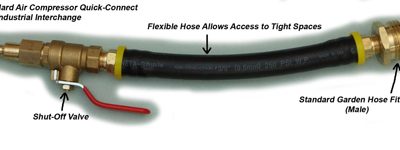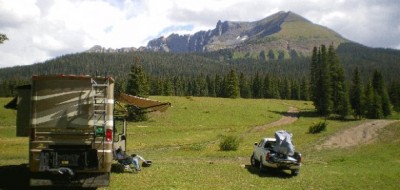 In last week’s post, Power to the people: Upgrade options for your electrical system, I wrote about various ways to increase your electrical capacity while dry-camping (boondocking). Now we will move on to drinking water, that natural resource that will limit your consecutive boondocking days unless you are Moses and can strike a stone with a rod and water gushes forth.
In last week’s post, Power to the people: Upgrade options for your electrical system, I wrote about various ways to increase your electrical capacity while dry-camping (boondocking). Now we will move on to drinking water, that natural resource that will limit your consecutive boondocking days unless you are Moses and can strike a stone with a rod and water gushes forth.
If you run out of water you can’t make coffee, spaghetti, or jello, brush your teeth, flush your toilet, wash and rinse dishes, shower, or have a nice cold glass of it. In fact, you are probably so used to just turning the spigot that until nothing but a drop or two dribbles out do you realize how thirsty you are.
That’s why boondockers have to plan, curbing the natural instinct (and wasteful habit) of unconsciously turning on the spigot without thought. It’s the same as flicking on the light switch and not considering the amps fleeing your batteries. You don’t have to be paranoid about it, but if you adopt the habit of thinking about the consequences of your actions, it becomes much easier–almost second nature–to mentally monitor your finite resources. And, of course, there’s the water level monitor gauge for you techies.
You need to know basically only two rules for managing your drinking water: (1) Carry more, (2) Use less. Carrying more is the easy part. There are a variety of containers in which you can carry additional water that can be loaded into your tow or toad for a water run without having to move your rig:
- One gallon plastic jugs – cheap, disposable or refillable, stow several in your RV’s nooks and crannies
- 2 1/2 gallon containers with a spigot – found in supermarkets, handy on a counter or picnic table for drinking
- reusable five-gallon collapsible containers – fold flat and stow easily when empty and can be used with the spigot or poured into the water tank
- five-gallon sun showers – fill with water from any source and shower au naturale by hanging from a tree
- six-gallon Jerry jugs – pour spout helps pour into water tank. Also strong arms.
- 45-gallon water bladders from Camping World – lots of extra water. Use with small 12-volt water pump to pump into water tank.
Use less. This is the harder part–breaking or adjusting old wasteful habits and adopting new conservative ones. But you can do it, and they will become second nature before you finish grousing about them. So . . . here are several ways to cut down on your water habit and extend your boondocking time:
- Take Navy showers – Turn water on, wet down–only enough to get wet–turn water off, soap up, turn water on, rinse–only enough to wash soap off–turn water off.
- Save warming-up water – Collect in plastic bucket or dishpan while shower warms up. Use to flush toilet, wash dishes.
- Don’t let the water flow while brushing teeth.
- Use dishwashing rinse water to flush toilet.
- Wipe the food off your dirty dishes and from pots and pans with paper towels. It will take less water to wash and rinse them, and food bits will not end up in your gray water tank creating unpleasant odors or fouling the probes.
- Wash dishes with just a small bowl of soapy water and a sponge or rag, then rinse them all at once in a plastic tub. Running water is a no-no.
There are more ways to conserve water usage that you will develop as you evolve into boondocking. Be creative and inventive, but the most useful tip is to be conscious of your water usage. Awareness = efficiency.
For more RVing articles and tips take a look at my Healthy RV Lifestyle website, where you will also find my ebooks: BOONDOCKING: Finding the Perfect Campsite on America’s Public Lands (PDF or Kindle), 111 Ways to Get the Biggest Bang for your RV Lifestyle Buck (PDF or Kindle), and Snowbird Guide to Boondocking in the Southwestern Deserts (PDF or Kindle), and my newest, The RV Lifestyle: Reflections of Life on the Road (Kindle reader version). NOTE: Use the Kindle version to read on iPad and iPhone or any device that has the free Kindle reader app.




